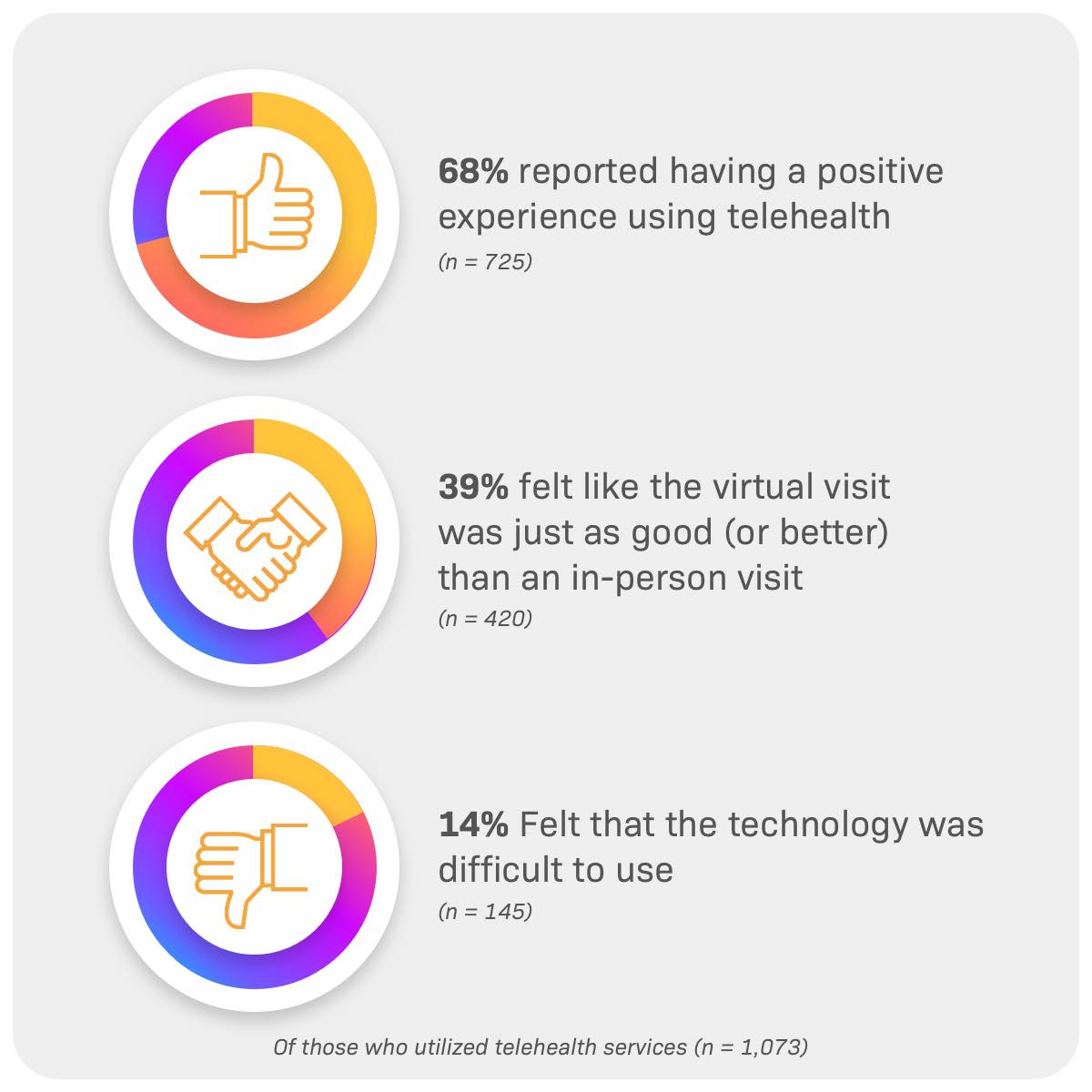Varying Satisfaction Levels Compared to In-Person Visits
Digging deeper into satisfaction levels among various groups of people can provide a better understanding of who is most likely to find value in telehealth as a healthcare delivery method going forward. It can also uncover who might need some extra resources before feeling comfortable with telehealth.
More than two-thirds of respondents who had used telehealth said they considered their experiences to be positive. However, that number doesn’t necessarily dictate a strong desire for long-term use. Additionally, reasons for telehealth visits – and, as a result, satisfaction – can vary greatly.

Comparing telehealth visits to in-person medical visits can provide more context. Overall, nearly four in 10 people who used telehealth said they felt their virtual visit was just as good as, or better than, an in-person visit.
In looking at the results more closely, it becomes clear that factors such as gender, education and income level play a role in satisfaction. For example, females found their virtual visit to be just as good as or better than an in-person visit compared to their male counterparts (40% vs. 32%). And respondents with a high school degree or below were more likely than those with advanced degrees to consider their virtual visits to be just as good or better than an in-person visit (47% vs. 36%).
A comparison across various income levels reveals that respondents with lower household incomes were more likely than those with high incomes to say their virtual visits were just as good as or better than their in-person visits. Specifically, this was the case for 42% of respondents with household incomes less than $30,000, 41% of those earning $30,000-$54,999 and 41% of those earning $55,000 – $99,999, compared to 30% of respondents with household incomes more than $100,000.
Data from additional waves of this survey demonstrated that, over time, convenience has remained a key positive factor as people compare telehealth to in-person visits. More than six in 10 of those respondents from that later survey rated convenience as at least somewhat better than in-person office visits. And respondents found in-person and telehealth visits to be roughly the same for a number of measurements, including the quality of conversation, the ability to ask questions or voice concerns and the amount of time spent with the HCP.
Long-Term Opportunities That Address Patient Needs
A number of the survey’s findings suggest that significant long-term opportunities exist for extending and expanding telehealth.
There is stated interest. Although 43% of respondents said they wanted to return to in-person appointments in the future, more than a quarter reported a desire to use telehealth even after the pandemic subsides. Decisions on whether to use telehealth will depend on a variety of factors, including the reason for the medical visit and physician availability, but the convenience factor will likely remain a draw even after patients are no longer quarantining. In fact, since respondents who felt they were at greater risk of COVID-19 were more likely to leverage telehealth, the technology is a valuable long-term option for individuals who are immunocompromised.
Findings from a later survey demonstrated that patients find telehealth visits most acceptable for the purpose of discussing treatments. For example, nearly three-fourths of respondents said they either preferred telehealth or were fine with either telehealth or an in-person visit when discussing a change in medication or treatment. Two-thirds of those respondents viewed telehealth similarly when it came to evaluating whether a new treatment is working.
Adoption by older patients is possible despite some obstacles. Adults over 55 were more likely than younger respondents to both express having no interest in telehealth and rate the technology as difficult to use. However, nearly half started using telehealth in response to COVID-19. This demonstrates that adoption is feasible if benefits outweigh perceived drawbacks.
Make the technology easy and accessible. Health Union’s survey findings demonstrate that individuals with lower household incomes were more satisfied with their experiences. Interestingly, however, according to Pew Research, people in lower income brackets tend to have the lowest technology adoption rates in terms of device or broadband access. These results suggest that telehealth as an access point that incorporates phone vs. online visits holds a lot of value.
Additionally, the survey revealed that nearly three-fourths of respondents who had spoken with an HCP about the virus did so over the phone. This shows that, for older patients and those in rural populations with less access, “simpler” technology like telephone communication could reduce some of the obstacles while providing a solid first step towards an efficient telehealth experience.
Patients can benefit from knowing about telehealth. Interestingly, those who had the most positive telehealth experiences were also least likely to hear about telehealth from their doctor’s office pertaining to COVID-19. As practices look to extend telehealth services beyond the pandemic, informing patients that it is available as an additional access point for their care may be instrumental in increasing uptake and maintaining continuity of care.
Health Union’s study, titled “Telemedicine Use and Health-Related Concerns of Patients With Chronic Conditions During COVID-19: Survey of Members of Online Health Communities” (DOI: 10.2196/23795), was published in February 2021 in the Journal of Medical Internet Research.
Amrita Bhowmick is chief community officer at Health Union.





